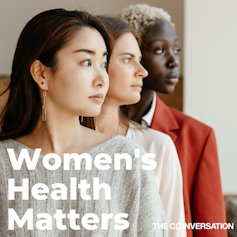Female sexual desire is frequently misunderstood. Despite desire (also known as libido or sex drive) being the most common sexual health concern for women, most women aren’t really taught about it growing up. And if they are, the information is often inaccurate.
This lack of education not only perpetuates misinformation, stigma and shame about female sexual desire, it can also have a major effect on wellbeing and perceptions of satisfaction in intimate relationships.
Discrepancies in sexual desire and satisfaction are often reported as key reasons for relationship difficulties. Low sexual desire also has a negative impact on body image and self-confidence.
But it’s never too late to understand desire and the many ways it can change – not just each day, but throughout life.

This article is part of Women’s Health Matters, a series about the health and wellbeing of women and girls around the world. From menopause to miscarriage, pleasure to pain the articles in this series will delve into the full spectrum of women’s health issues to provide valuable information, insights and resources for women of all ages.
You may be interested in:
The orgasm gap and why women climax less than men
How tracking menopause symptoms can give women more control over their health
Desire is constantly changing
Sexual desire is best understood as a transient state. This means it can be affected by an array of factors – including stress, hormones, physical and mental health, certain medications, lifestyle and the balance of intimacy and eroticism in a relationship.
Desire is also a multifaceted response, which can either follow or occur at the same time as pleasure or arousal. This means feeling “in the mood” may not happen until after a woman is aroused. Desire can also occur with or without a partner and will vary in frequency and intensity. Sexual desire can also be affected by many environmental factors, which helps explain why it may wane during periods of stress or in longer term relationships.
Even factors such as gender roles and norms are thought to cause low sexual desire for women in heterosexual relationships. One study proposes that the inequities in the division of household labour, the objectification of women and gender norms surrounding sexual initiation (in which men are presumed to be the primary instigators of sex while women are presumed coy), all result in low sexual desire for women.
Understanding that desire is a transient and multifaceted response can help women to see that low desire isn’t a problem with our bodies – and that treating it may be a matter of addressing problems in other parts of their lives. It also helps to understand that it’s normal for desire to change and fluctuate, even on a daily basis, depending on what’s going on in a person’s life.
Certain life transitions can have a major effect
Pregnancy, the post-partum period, perimenopause and menopause are all significant transitional periods in women’s lives that can also have a major impact on sexual desire.
There are a number of reasons why this may be. For example, body changes that may happen during these transitional periods can affect body image and self-esteem, which in turn affects desire. Hormone changes can affect mood, and may also result in physical changes – such as vaginal dryness and dyspareunia (genital pain that occurs before, during or after sex), which are known to affect desire.
Perineal trauma (damage to the perineum during birth) can cause pain which may make women desire sex less. Experiences of pregnancy loss and infertility are also shown to lower sexual desire.
Importantly, these life transitions also affect other areas of our lives – and may lead to stress, fatigue, changes in relationship roles and less time for intimacy. This can all, in turn, lead to lower sexual desire.

Expecting that sexual desire may change or decrease during these periods can be helpful, as it may reduce self-blame and shame.
Desire can be cultivated
Desire can be cultivated at any stage of life. Recent psychosocial approaches to addressing low sexual desire emphasise the importance of balancing intimacy and eroticism, which is a focus on sensuality and pleasure over arousal and orgasm. Research indicates that, while intimacy is essential in healthy partnered sexuality, eroticism helps increase desire by promoting mystery and sexual excitement.
Sexual desire experts also suggest good strategies for cultivating desire including regularly communicating what feels good and what doesn’t with your partner, planning for sexual activity and finding ways to reduce distraction so you can focus on your body during sex.
Evidence-based treatments for low desire include mindfulness therapy, which can help women reduce distraction, increase focus on the sensations, thoughts and emotions they’re experiencing in the moment and help target negative self-judgment. Another treatment, sensate focus touch, which involves using non-sexual touch to promote more open sexual communication among couples, has also been shown to increase desire.
Sexual desire is unique to each person. If women were taught what sexual desire is and what to expect across our lives, they would be less likely to suffer the ill effects of this misunderstanding. Sexual desire is not a problem to be solved – but a skill to be learned and cultivated throughout life.

